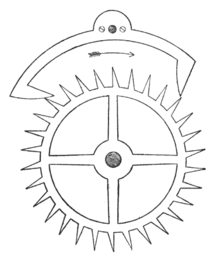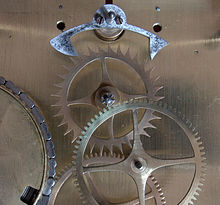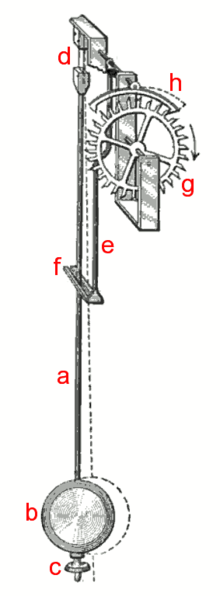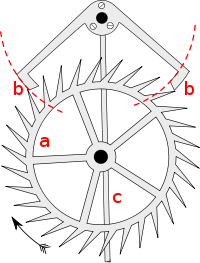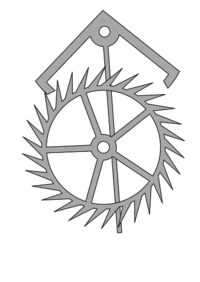- Anchor escapement
-
In horology, the recoil or anchor escapement is a type of escapement used in pendulum clocks. An escapement is the mechanism in a mechanical clock that maintains the swing of the pendulum and allows the clock's wheels to advance a fixed amount with each swing, moving the hands forward. The anchor escapement was probably invented by British scientist Robert Hooke[1][2] around 1657,[3][4] although some references credit clockmaker William Clement[4][5][6] who popularized the anchor in his invention of the longcase or grandfather clock around 1680, and disputed credit for the escapement with Hooke.[4] Joseph Knibb probably built the first working anchor clock at Wadham College, Oxford, around 1670.[7] The anchor became the escapement used in almost all pendulum clocks. A more accurate variation called the deadbeat escapement was introduced by British clockmaker Richard Towneley around 1675. This gradually superseded the anchor and is used in virtually all modern pendulum clocks.
Contents
How it works
The anchor escapement consists of two parts; the escape wheel, which is a vertical wheel with pointed teeth on it rather like saw teeth, and the anchor, shaped vaguely like a ship's anchor, which swings back and forth on a pivot just above the escape wheel. On the two arms of the anchor are angled flat faces which the teeth of the escape wheel push against, called pallets. The central shaft of the anchor is attached to the pendulum, so the anchor swings back and forth, with the pallets alternately catching and releasing an escape wheel tooth on each side.
Each time one pallet moves away from the escape wheel, releasing a tooth, the wheel turns and a tooth on the other side catches on the other pallet, which is moving toward the wheel. The momentum of the pendulum continues to move the second pallet toward the wheel, pushing the escape wheel backwards for a distance, until the pendulum reverses direction and the pallet begins to move away from the wheel, with the tooth sliding along its surface, pushing it. Then the tooth slides off the end of the pallet, beginning the cycle again.
Neither the anchor escapement nor the deadbeat form, below, are self starting. The pendulum must be given a swing to get them going.
Recoil
The backward motion of the escape wheel during part of the cycle, called recoil, is one of the disadvantages of the anchor escapement. It results in a reversal of the entire wheel train back to the driving weight with each tick of the clock, causing backlash in the wheel train, excessive wear to the gear teeth, and inaccuracy. It can also cause the points of the escape wheel teeth to dig into the pallet surface. The teeth are slanted backward, opposite the direction of rotation, and the surface of the pallets is slightly convex, to prevent this.[8]
Another reason the escape wheel teeth are slanted backward is as a safety measure. If the clock is moved without immobilising the pendulum, the uncontrolled swinging of the pendulum can cause the anchor pallets to collide violently with the escape wheel. The slanted teeth ensure that the flat faces of the anchor pallets hit the sides of the teeth first, protecting the delicate points from being broken.[8]
The more modern deadbeat escapement (below) doesn't have recoil. One way to determine whether an antique pendulum clock has an anchor or deadbeat escapement is to observe the second hand. If it moves backward slightly after every tick, showing recoil, the clock has an anchor escapement.
Crutch and fork
The shaft of the anchor, called the crutch ends in a fork which embraces the shaft of the pendulum, giving it transverse impulses. The pendulum rod is hung from a short straight suspension spring attached to a sturdy support directly behind the anchor. The pivot of the anchor is aligned with the bending point of the spring. This arrangement results in a more stable pendulum support than simply suspending the pendulum directly from the anchor.
Design details
The anchor is very tolerant of variations in its geometry, so its shape varied widely.[8] In late 19th century, in Britain, the usual design[8] was a 90° angle between the pallets, which meant locating the anchor pivot a distance of √2 ≈ 1.4 times the escape wheel diameter from the escape wheel pivot. In a grandfather clock, which had a pendulum which swung once per second, the escape wheel often had 30 teeth, which made the escape wheel rotate once per minute so the second hand could be attached to its shaft. In a 30 tooth escape wheel the pallets span about 7½ teeth. The impulse angle of the pallets, which determined the swing of the pendulum, was 3°-4°.
History
The anchor was the second widely used escapement in Europe, replacing the 400 year old verge escapement in pendulum clocks. The pendulums in verge escapement clocks had very wide swings of 80° to 100°. In 1673, 17 years after he invented the pendulum clock, Christiaan Huygens published his mathematical analysis of pendulums, Horologium Oscillatorium. In it he showed that the wide pendulum swings of verge clocks caused them to be inaccurate, because it made the period of oscillation of the pendulum vary with unavoidable changes in drive force. The widespread realization that only small pendulum swings were isochronous motivated clockmakers to look for an escapement that could deliver small swings.
The chief advantage of the anchor was that by locating the pallets farther from the pivot, the swing of the pendulum was reduced from around 100° in verge clocks to only 4°-6°.[3] In addition to the improved accuracy due to isochronism, this allowed clocks to use longer pendulums, which had a slower 'beat'. Lower air drag meant they needed less power to keep swinging, and caused less wear on the clock's movement. The anchor also allowed the use of a heavier pendulum bob for a given drive force, making the pendulum more independent of the escapement (higher Q), and thus more accurate. These long pendulums required long narrow clock cases. Around 1680 British clockmaker William Clement began selling the first commercial clocks to use the anchor escapement, tall freestanding clocks with 1 meter (39 inch) seconds pendulums that came to be called longcase or 'grandfather' clocks.[9] The anchor increased the accuracy of clocks so much that around 1680–1690 the use of the minute hand, formerly the exception in clocks, became the rule[10]
The anchor escapement replaced the verge in pendulum clocks within about 50 years, although French clockmakers continued to use verges until about 1800. Many verge clocks were rebuilt with anchors. In the 18th century the more accurate deadbeat form of the escapement replaced the anchor in precision regulators, but the anchor remained the workhorse in home pendulum clocks. During the 19th century the deadbeat form gradually took over in most quality clocks, but the anchor form is still used in a few pendulum clocks today.[3]
Disadvantages
The anchor escapement is reliable and tolerant of large geometrical errors in its construction, but its operation is similar to the old verge escapement, and retains two of the major disadvantages of the verge:
- It is a frictional escapement; the pendulum is always being pushed by an escape wheel tooth throughout its cycle, and never allowed to swing freely. This makes the clock's rate sensitive to changes in the drive force, a problem called lack of isochronism. Any small changes in the force applied to the pallets, by a change in lubrication or the declining force of the clock's mainspring as it runs down for example, will change the period of the pendulum's swing. Anchor clocks driven by a mainspring slowed down slightly as the mainspring unwound, and required a fusee to even out the force of the mainspring to be accurate.
- It is a recoil escapement as mentioned above; the momentum of the pendulum pushes the escape wheel backward during part of the cycle. This causes extra wear to the movement, and the backlash of the gear train applies varying force to the pendulum, causing inaccuracy.
Deadbeat escapement
The above two problems were remedied by a modification to the pallets, resulting in a much better variation of the anchor escapement: the Graham or deadbeat escapement. This is often erroneously credited to English clockmaker George Graham who introduced it around 1715 in his precision regulator clocks.[11][12][13][14] However it was actually invented around 1675 by Richard Towneley, and first used by Graham's mentor Thomas Tompion in a clock built for Sir Jonas Moore, and in the two precision regulators he made for the new Greenwich Observatory in 1676,[15] mentioned in correspondence between Astronomer Royal John Flamsteed and Towneley[16][17]
The deadbeat form of the anchor escapement was initially used only in precision clocks, but due to its superior accuracy its use spread during the 19th century to most quality pendulum clocks. Almost all pendulum clocks made today use it. The deadbeat escapement does rely on a quality wheel train to receive constant impulse. Variations in the impulse will affect the pendulum arc and the accuracy of the clock. For this reason it is not always the best choice for cheap mass produced clocks, or for tower clocks with large hands exposed to the outside weather.
How it works
The deadbeat has a second face on the pallets, called the 'locking' or 'dead' face, with a curved surface concentric with the axis on which the anchor rotates.[3] When an escape wheel tooth is resting against one of these faces, its force is directed through the anchor's pivot axis, so it gives no impulse to the pendulum, allowing it to swing freely. When the pallet on the other side releases the escape wheel, a tooth lands on this "dead" face first, and remains resting lightly against it for most of the pendulum's outward swing and return. For this period the escape wheel is "locked" and unable to turn. Near the bottom of the pendulum's swing the tooth slides off the dead face onto the slanted 'impulse' face of the pallet, allowing the escape wheel to turn and give the pendulum a push, before dropping off the pallet. The drag of the escape tooth on the dead face does add a small amount of friction to the pendulum's swing, but it is usually negligible.
In contrast to the backward slant of the anchor escape wheel teeth, the deadbeat escape wheel teeth are radial or slant forward to ensure that the tooth makes contact with the 'dead' face of the pallet, preventing recoil.[3]
The Airy condition
In 1826 British astronomer George Airy proved that a pendulum that is driven by a drive impulse that is symmetrical about its bottom equilibrium position is isochronous for different drive forces, ignoring friction, and that the deadbeat escapement approximately satisfies this condition.[18][19] It would be exactly satisfied if the escape wheel teeth were made to fall exactly on the corner between the two pallet faces, but for the escapement to operate reliably the teeth must be made to fall above the corner, on the 'dead' face.[20]
Comparison of motion in anchor and deadbeat
A major cause of error in clocks is changes in the drive force applied to the escapement, caused by small changes in the friction of the gears or the pallets, or the diminishing force of the mainspring as it unwinds. An escapement in which changes in drive force do not affect the rate is called isochronous. The superior performance of the deadbeat over the anchor is caused by its improved isochronism. This is due to the different ways changes in drive force affect the swing of the pendulum in the two escapements:[2]
- In the anchor escapement, an increase of drive force causes the pendulum to swing back and forth more quickly, but does not increase the pendulum's amplitude, the length of its swing, much. The increased force of the escape wheel tooth on the pallet during the recoil part of the cycle tends to decrease the pendulum's swing, while the force of the tooth during the forward impulse part of the cycle tends to increase the pendulum's swing. These tend to cancel each other out, leaving the swing unchanged. But both these effects decrease the time of swing. In other words, increased force knocks the pendulum back and forth in a fixed arc faster.
- In the deadbeat escapement, increased drive force does not change the period of the pendulum much, resulting in better isochronism and better timekeeping, but it does increase the pendulum's swing. Since the escapement doesn't have a recoil period when the tooth's force opposes the direction of the pendulum's motion, increased force causes the pendulum to swing in a wider arc, as well as move faster. The time required to cover the extra distance exactly compensates for the increased speed of the pendulum, leaving the period of swing unchanged.
When the deadbeat was invented, clockmakers initially believed it had inferior isochronism to the anchor, because of the greater effect of changes in force on the pendulum's amplitude.[2]
See also
References
- ^ Milham, Willis I. (1945). Time and Timekeepers. MacMillan. ISBN 0780800087. p.146
- ^ a b c Glasgow, David (1885). Watch and Clock Making. London: Cassel & Co.. p. 293. http://books.google.com/?id=9wUFAAAAQAAJ&pg=PA124.
- ^ a b c d e Headrick, Michael (2002). "Origin and Evolution of the Anchor Clock Escapement". Control Systems magazine, (Inst. of Electrical and Electronic Engineers) 22 (2). Archived from the original on 2009-10-25. http://web.archive.org/web/20091025120920/http://geocities.com/mvhw/anchor.html. Retrieved 2007-06-06.
- ^ a b c Reid, Thomas (1832). Treatise on Clock and Watch-making, Theoretical and Practical. Philadelphia, USA: Carey & Lea. p. 184. http://books.google.com/?id=BB8JAAAAIAAJ&pg=PA184.
- ^ Beckett, Edmund (Lord Grimsthorpe) (1874). A Rudimentary Treatise on Clocks and Watches and Bells, 6th Ed.. London: Lockwood & Co.. p. 71. http://books.google.com/?id=OvQ3AAAAMAAJ&pg=PA75.
- ^ Usher, Abbott Payson (1988). A History of Mechanical Inventions. Courier Dover. pp. 313. ISBN 048625593X. http://books.google.com/?id=xuDDqqa8FlwC&pg=PA312.
- ^ Chapman, Allen (2005). England's Leonardo: Robert Hooke and the Seventeenth Century Scientific Revolution. CRC Press. p. 84. ISBN 0750309873. http://books.google.com/?id=OH_c_21OG6MC&pg=RA1-PA84.
- ^ a b c d Britten, Frederick J. (1896). The Watch and Clock Maker's Handbook, 9th Ed.. London: E.F. & N. Spon. pp. 8–11. http://books.google.com/?id=5SYJAAAAIAAJ&pg=PA8.
- ^ Moore, N. Hudson (1936). The Old Clock Book. Tudor. p. 40. http://books.google.com/?id=HpFCAAAAIAAJ&dq=grandfather+anchor+clock&q=anchor.
- ^ Milham 1945, p.146
- ^ Milham 1945, p.185
- ^ Glasgow 1885, p.297
- ^ "Clocks". Encyclopaedia Britannica, 11th Ed.. 6. The Encyclopaedia Britannica Co.. 1910. p. 541. http://books.google.com/?id=b5rSQtoe0LcC&dq=dead+escapement+Graham&pg=PA543&lpg=PA543&q=graham.
- ^ "Deadbeat escapement". Encyclopedia of Clocks and Watches. Old and Sold Antiques Marketplace. http://www.oldandsold.com/articles02/clocks-d.shtml. Retrieved 2008-06-08.
- ^ Betts, Jonathan Regulators in Bud, Robert; Warner, Debra Jean (1998). Instruments of Science: An Historical Encyclopedia. Taylor & Francis. ISBN 0815315619. p.121
- ^ Flamsteed, John; Forbes, Eric; Murdin, Lesley (1995). The Correspondence of John Flamsteed, First Astronomer Royal, Vol.1. CRC Press. ISBN 9780750301473. http://books.google.com/?id=Hrm9aCi48CYC&pg=PA376. Letter 229 Flamsteed to Towneley (September 22, 1675), p.374, and Annotation 11 p.375
- ^ Andrewes, W.J.H. Clocks and Watches: The leap to precision in Macey, Samuel (1994). Encyclopedia of Time. Taylor & Francis. ISBN 0815306156. p.126, this cites a letter of December 11, but he may have meant the September 22 letter mentioned above.
- ^ Airy, George Biddle (November 26, 1826). "On the Disturbances of Pendulums and Balances and on the Theory of Escapements". Trans. of the Cambridge Philosophical Society (University Press) 3 (Part 1): 105. http://books.google.com/?id=xQEBAAAAYAAJ&pg=PA105. Retrieved 2008-04-25.
- ^ Beckett 1874, p.75-79
- ^ Beckett 1874, p.75
External links
- Headrick, Michael (2002). "Origin and Evolution of the Anchor Clock Escapement". Control Systems magazine, (Inst. of Electrical and Electronic Engineers) 22 (2). Archived from the original on 2009-10-25. http://web.archive.org/web/20091025120920/http://geocities.com/mvhw/anchor.html. Retrieved 2007-06-06. -dead link
- Glasgow, David (1885). Watch and Clock Making. London: Cassel & Co.. p. 293. http://books.google.com/?id=9wUFAAAAQAAJ&pg=PA124. on Google Books. Details of construction.
Categories:- Escapements
Wikimedia Foundation. 2010.

